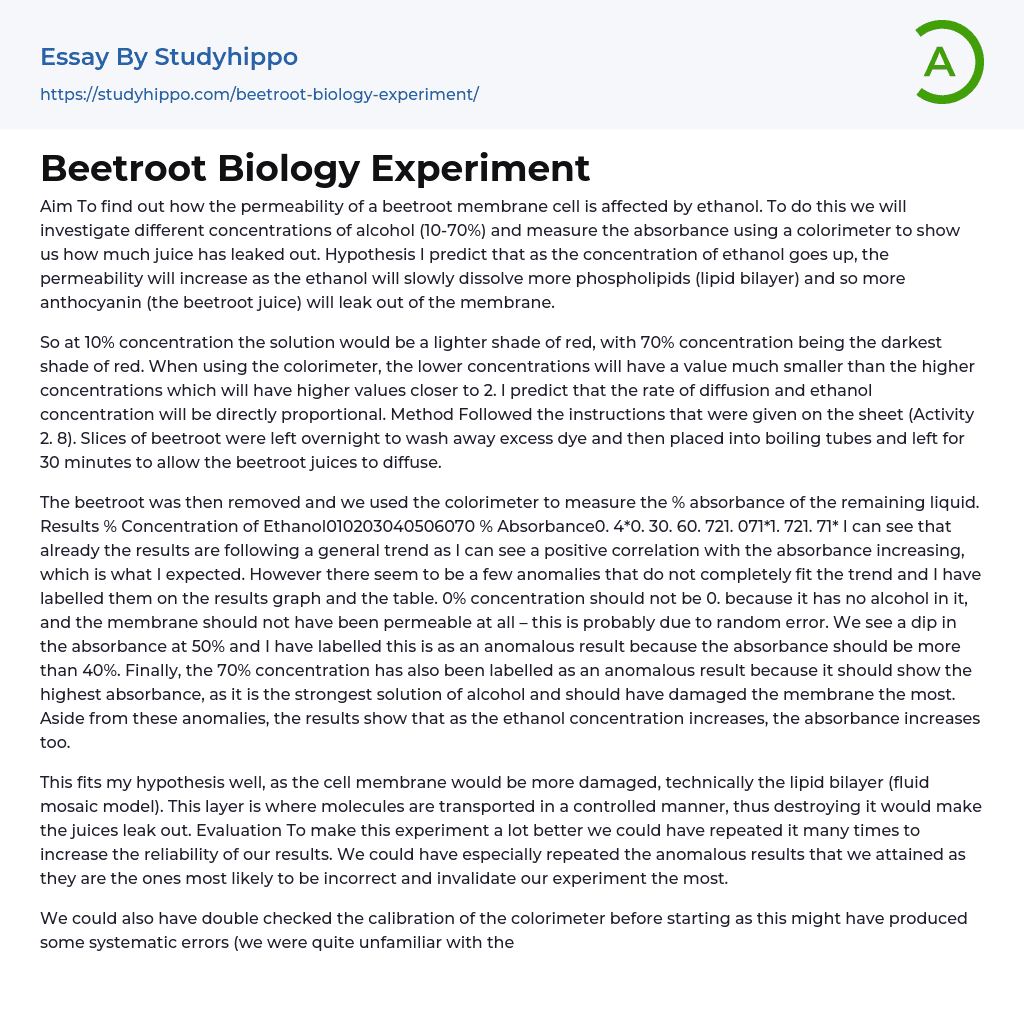Aim To find out how the permeability of a beetroot membrane cell is affected by ethanol. To do this we will investigate different concentrations of alcohol (10-70%) and measure the absorbance using a colorimeter to show us how much juice has leaked out. Hypothesis I predict that as the concentration of ethanol goes up, the permeability will increase as the ethanol will slowly dissolve more phospholipids (lipid bilayer) and so more anthocyanin (the beetroot juice) will leak out of the membrane.
So at 10% concentration the solution would be a lighter shade of red, with 70% concentration being the darkest shade of red. When using the colorimeter, the lower concentrations will have a value much smaller than the higher concentrations which will have higher values closer to 2. I predict t
...hat the rate of diffusion and ethanol concentration will be directly proportional. Method Followed the instructions that were given on the sheet (Activity 2. 8). Slices of beetroot were left overnight to wash away excess dye and then placed into boiling tubes and left for 30 minutes to allow the beetroot juices to diffuse.
The beetroot was then removed and we used the colorimeter to measure the % absorbance of the remaining liquid. Results % Concentration of Ethanol010203040506070 % Absorbance0. 4*0. 30. 60. 721. 071*1. 721. 71* I can see that already the results are following a general trend as I can see a positive correlation with the absorbance increasing, which is what I expected. However there seem to be a few anomalies that do not completely fit the trend and I have labelled them on the results graph and th
table. 0% concentration should not be 0. because it has no alcohol in it, and the membrane should not have been permeable at all – this is probably due to random error. We see a dip in the absorbance at 50% and I have labelled this is as an anomalous result because the absorbance should be more than 40%. Finally, the 70% concentration has also been labelled as an anomalous result because it should show the highest absorbance, as it is the strongest solution of alcohol and should have damaged the membrane the most. Aside from these anomalies, the results show that as the ethanol concentration increases, the absorbance increases too.
This fits my hypothesis well, as the cell membrane would be more damaged, technically the lipid bilayer (fluid mosaic model). This layer is where molecules are transported in a controlled manner, thus destroying it would make the juices leak out. Evaluation To make this experiment a lot better we could have repeated it many times to increase the reliability of our results. We could have especially repeated the anomalous results that we attained as they are the ones most likely to be incorrect and invalidate our experiment the most.
We could also have double checked the calibration of the colorimeter before starting as this might have produced some systematic errors (we were quite unfamiliar with the use of a colorimeter too). Other random errors that might have occurred would be for example the cutting of the beetroot slices might not have been done accurately. Other variables were not controlled, such as the temperature (which was room temperature, which changes and is not
controlled in any way) which is also known to have an effect on the permeability of the membrane of beetroot – as there will be more kinetic energy when the temperature is increased.
- Bacteria essays
- Biotechnology essays
- Breeding essays
- Cell essays
- Cell Membrane essays
- Cystic Fibrosis essays
- Enzyme essays
- Human essays
- Microbiology essays
- Natural Selection essays
- Photosynthesis essays
- Plant essays
- Protein essays
- Stem Cell essays
- Viruses essays
- Acid essays
- Calcium essays
- Carbohydrate essays
- Carbon essays
- Chemical Bond essays
- Chemical Reaction essays
- Chemical reactions essays
- Chromatography essays
- Concentration essays
- Copper essays
- Diffusion essays
- Ethanol essays
- Hydrogen essays
- Organic Chemistry essays
- Osmosis essays
- Periodic Table essays
- Ph essays
- Salt essays
- Sodium essays
- Titration essays
- Experiment essays
- Explorer essays
- Hypothesis essays
- Observation essays
- Qualitative Research essays
- Research Methods essays
- Theory essays




